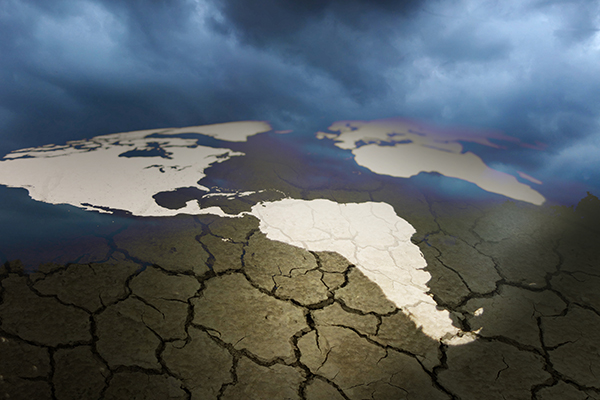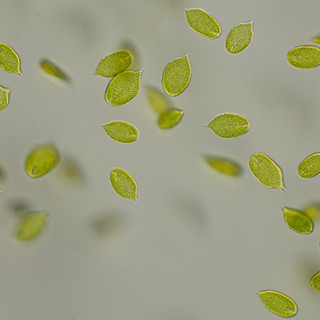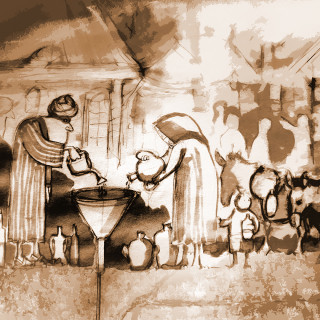The earth is both inundated and drying up
The earth is both inundated and drying up. Water supply is a complex phenomenon that has probably never been more complicated – or more important – than now. Kenneth M. Persson is a professor of water resources engineering and he took the initiative for Lund University’s Water Portal, which involves over 200 water researchers.
“The absolute greatest threat to well-functioning water management is drought”, he says.
Most experts are agreed on this. It may not be a serious problem in Sweden, but in California the almond trees and orange groves are dying. While those in the US may be able to put food on the table anyway, people in East Africa are forced to eat up next year’s seed in order to avoid starvation. In the Sahel region north of the equator, animals are sent to early slaughter when the grass withers. In Asia, millet and durra harvests dry up.
Prolonged drought not only leads to hunger and death. It can also affect food security and give rise to conflicts.
“People who are hungry do not have the energy to think ahead. Parents whose children have died for lack of water naturally suffer on many levels. The people in the Sahel region, south of the Sahara desert, are particularly vulnerable”, says Professor Persson.
Drought is a result of a combination of environmental problems, each of which is a challenge in itself. The most obvious one is increased carbon dioxide emissions, because a warmer climate increases evaporation from the ground. The greenhouse effect has also transformed seasonal dry periods into year-long droughts.
Large swathes of arable land that were previously classed as ‘dry but nonetheless usable’ are now ‘completely dry and largely unusable’. Neither is it of much comfort that if and when the rain does come, it is usually in the form of intensive periods of rain that wash away entire fields, as a consequence of the more erratic weather extremes caused by the greenhouse effect.
Paradoxically, the greenhouse effect also leads to some areas becoming continually wetter and suffering flooding. This is another challenge, but it is manageable in a way that drought is not.
“It is possible to build cities that can withstand floods. That is technically feasible”, says Kenneth M. Persson.
Drought is also exacerbated by the rapid deforestation of large parts of the planet to make space for cultivation and grazing land. This means that the groundwater that normally circulates in an area, as dew in the morning and under the crown of the trees during the day, evaporates for good. The water disappears with the vegetation.
“Reforestation in agricultural landscapes is therefore of major significance for water economy. In countries like India and Niger, where measures have been introduced to support soil improvement and educate farmers, harvests are better.”
Another growing agricultural phenomenon that according to Kenneth M. Persson creates problems is monoculture. This occurs around the world and is when farmers grow one single profitable crop over vast areas. Sugar cane, maize and cotton are examples of crops that are in demand and therefore lucrative.
“Short-term yields and income may increase, but in the longer term this unbalanced use of agricultural land is simply sub-optimisation. Unbalanced cultivation depletes the soil, and the same pests keep returning, which often leads farmers to use pesticides.”
Pollution is another major and accelerating threat to water. It is true that much is being done to process and purify waste, but because much of the material humans manufacture contains persistent pollutants – i.e. organic substances that are resistant to decomposition – a lot of pollution is released nonetheless.
Sooner or later, all these substances that are difficult to break down end up in water. Plastics, chemicals, pharmaceutical substances – all of them run into watercourses, leach into groundwater or are dumped in the sea.
“This is because water is the world’s best solvent. There is no known substance that water cannot dissolve to some extent”, says Professor Persson, who believes that our grandchildren will think we were idiots not to stop the accelerating pollution of the ecosystem despite knowing better. Our rubbish dumps and piles of possessions are hardly shrinking.
But perhaps decision-makers do not have enough information?
“Oh yes they do. We have known about this ever since Rachel Carson wrote Silent Spring in 1962”, says Kenneth M. Persson, who explains that he had the book as supplementary reading at school in Skivarp in 1976.
Besides drought and pollution, he points out a third factor that cannot be described as a threat, but that nonetheless hampers the development and renewal of the water industry. For want of a better term, Kenneth M. Persson calls the problem “administrative complications”, but it is a much more diverse issue than that.
“One way of looking at it is that water and sewerage systems are built on a business model that makes it difficult for suppliers to charge a proper amount. As early as 1776, Adam Smith observed in The Wealth of Nations that water is the most useful substance on earth while diamonds are basically useless. Nevertheless, water has a low value and diamonds a high one. We take water for granted and set its value accordingly.”
According to Professor Persson, this phenomenon still applies everywhere, not just in Sweden where there is good access to fresh water.
“In countries where people buy their drinking water bottled, the cost of developing a drinking water supply system could be quickly recouped. Yet this is not done, for multiple reasons. There are business interests that want to protect the bottled water market, there are inefficient systems where water payments are used for other purposes, and there are water mains with more leaks that supply points.”
Water supply is undeniably a natural monopoly that is largely impossible to privatise. It is not possible to build more pipes or pump water from different sources through the same pipe (this would damage the pipes for one thing), and it is certainly not possible to keep track of how much waste water different households flush away in order to bill each household for the correct amount.
Monopolies usually mean an expensive deal for the end user, but with water the effect is reversed if the monopoly on water services, as they are called in Swedish legislation from 2006, is administered correctly. That is of course a good thing. The minor disadvantage in a Swedish context is that there is also great caution about raising the rates since they are set politically.
So what about the future? The situation does look fairly bleak, doesn’t it…?
“Water is an example of a substance that is owned and managed by everyone and as a result is not owned or managed by anyone. Economists call this phenomenon the ‘tragedy of the commons’. Nonetheless, awareness is growing of the value of conserving and managing water wisely. What is taking place at Lund University and other research organisations in water education and research can guide decision-makers. However, we must become better at communicating our findings and spreading the ideas to other stakeholders”, says Kenneth M. Persson, adding:
“The energy generated at meetings of researchers within the Water Portal seems like it should be sufficient to heat all the tea and coffee we drink when we meet. So we will manage to solve this.”
Text: Kristina Lindgärde
Foto: Catrin Jakobsson







